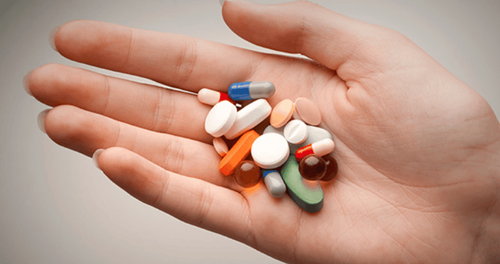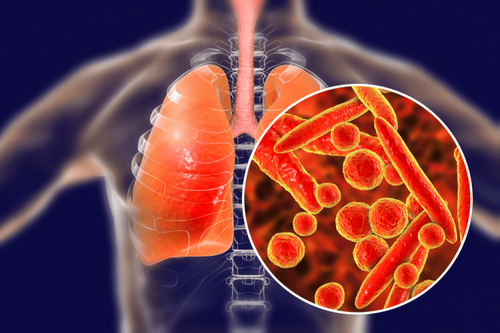This is an automatically translated article.
Capreomycin is made in the form of a powder for injection, with the main ingredient being Capreomycin. The drug is used in the treatment of drug-resistant tuberculosis.
1. What is Capreomycin?
What is Capreomycin? Capreomycin is an antibiotic, an anti-tuberculosis drug, prepared in the form of a powder for injection. Capreomycin sulfate is equivalent to 1g of Capreomycin base.
Capreomycin is a polypeptide antibiotic, extracted from Streptomyces capreolus with bacteriostatic effect. The drug is active against strains of Mycobacterium tuberculosis, M. kansasii, M.bovis and M. avium. Besides, at high concentrations, Capreomycin is also effective against some strains of gram-negative and gram-positive bacteria.
Capreomycin is one of the group 2 anti-tuberculosis drugs (injectable anti-tuberculosis drugs), used to treat drug-resistant tuberculosis, used together with other anti-tuberculosis drugs. Only use Capreomycin if treatment with first-line anti-TB drugs is ineffective or contraindicated.
Indications for the use of Capreomycin:
Treatment of drug-resistant tuberculosis with known or anticipated drug-susceptible strains of M. tuberculosis, especially in cases of multidrug resistance (simultaneous resistance to rifampicin and isoniazid). ) or the patient is intolerant to first-line anti-tuberculosis drugs; Combination with 2 - 4 other TB drugs known or expected to be effective against resistant strains of M. tuberculosis. Contraindications to the use of Capreomycin:
Patients with hypersensitivity to Capreomycin or other components of the drug.
2. How to take and dose of Capreomycin
How to use: Capreomycin can be used intramuscularly or intravenously. Specifically:
Intramuscular injection: Dissolve 1g vial of Capreomycin sulfate in 2ml of 0.9% sodium chloride injection solution. Wait about 2 - 3 minutes before starting the injection (for the medicine to dissolve completely). Then, use the reconstituted capreomycin sulphate intramuscularly deep into a large muscle mass (because a shallow injection can cause more pain, causing a sterile abscess); Intravenous infusion: Dissolve Capreomycin in 100ml of 0.9% sodium chloride injection solution, infuse slowly intravenously over 60 minutes. Dosage:
Adults: To treat tuberculosis, Capreomycin is always used in combination with other anti-TB drugs at a daily dose of 15 - 20 mg/kg or up to 1 g (Capreomycin base) x 1 time / day for 60 - 120 day. After that, use 1g dose, inject 2-3 times/week; Patients with renal impairment: The dose of Capreomycin should be reduced according to creatinine clearance. Specifically: Creatinine clearance > 110ml/min: The daily dose is similar to the usual dose, 14mg/kg/48 hours every other day; Creatinine clearance 110ml/min: Daily dose is 13.9mg, every other dose is 14mg/kg/48 hours; Creatinine clearance 100ml/min: Daily dose is 12.7mg, every other dose is 14mg/kg/48 hours; Creatinine clearance 80ml/min: Daily dose is 10.4mg, every other dose is 14mg/kg/48 hours; Creatinine clearance 60ml/min: Daily dose is 8.2 mg, every other dose is 14mg/kg/48 hours; Creatinine clearance 50ml/min: Daily dose is 7.0mg, every other dose is 14mg/kg/48 hours; Creatinine clearance 40ml/min: Daily dose is 5.9mg, every other dose is 11.7mg/kg/48 hours; Creatinine clearance 30ml/min: Daily dose is 4.7mg, alternate dose is 9.5mg/kg/48 hours or 14.4mg/kg/72 hours; Creatinine clearance 20ml/min: Daily dose is 3.6mg, alternate dose is 7.2mg/kg/48 hours or 10.7mg/kg/72 hours 4.9mg/kg/48 hours or 7.3mg/ kg/72 hours; Creatinine clearance 10ml/min: Daily dose is 2.4mg, every other dose is 7.2mg/kg/48 hours or 10.7mg/kg/72 hours 4.9mg/kg/48 hours or 7.3mg/ kg/72 hours; Creatinine clearance 0ml/min: Daily dose is 1.3mg, every other day is 2.6 mg/kg/48 hours or 3.9 mg/kg/72 hours Children: Adjust dose according to age: Children under 15 years old or weighing ≤ 40kg: Use dose 15 - 30mg/kg/day (maximum 1g/day) x 1 time/day or 2 times/week; Children 15 years and older: 15mg/kg/day (maximum 1g/day) x 5-7 times/week for the first 2-4 months or until culture results improve. After that, the dose can be reduced to 15mg/kg/day (maximum 1g/day), used 2-3 times/week depending on the effectiveness of other drugs in the treatment regimen; Elderly: Due to an increased risk of renal dysfunction and hearing loss, the dose should be used at the lower end of the dose range. Patients over 59 years of age should receive a dose of 10mg/kg (maximum 750mg/day), daily dose in the induction phase, 2 - 3 times/week in the maintenance phase; Patients with hepatic impairment: There is no information on the dose of Capreomycin, it should be used with caution. Missed dose: Capreomycin is used in medical facilities, by medical staff, with monitoring throughout the course of treatment, so there is usually no missed dose.
Overdose: When using an overdose of Capreomycin, patients may manifest in the form of side effects of the drug but are more serious, mainly toxic reactions to the kidneys and hearing such as dizziness, buzzing. ears, shallow or weak breathing, oliguria or anuria. Patients using Capreomycin drug overdose can also have hypocalcemia, hypokalemia, hypomagnesaemia, electrolyte disturbances, like Bartter's syndrome,...
The treatment of Capreomycin overdose is mainly therapeutic. symptoms and supportive treatment. The patient is protected by airway protection, assisted ventilation, intravenous fluids, closely monitored vital signs, blood gases, serum electrolytes, and maintained at an appropriate level. In addition, the patient's fluid, electrolyte, and creatinine clearance should be closely monitored. Hemodialysis may increase the elimination of Capreomycin (especially in patients with impaired renal function). Patients with normal renal function should be adequately hydrated to maintain a urine output of 3 - 5 ml/kg/hour.
3. Capreomycin side effects
During the use of Capreomycin, patients may encounter some side effects such as:
Common: Kidney toxicity: Usually reversible after stopping taking Capreomycin, rarely fatal. In elderly patients, those with dehydration or renal dysfunction, the concomitant use of Capreomycin with other nephrotoxic drugs may increase the risk of acute tubular necrosis; Ototoxicity: Tinnitus, hearing loss, deafness, ... may be reversible or irreversible after stopping taking Capreomycin. Symptoms of dizziness, dizziness, tinnitus, loss of ability to perceive high tones, ... have been reported in patients using Capreomycin with abnormal kidney function, dehydration or taking toxic drugs. auditory calculation; Liver: Impaired liver function (decreased secretion of BSP, no increase in ALT, AST); Hematology: Leukopenia, leukocytosis, thrombocytopenia, eosinophilia (mild); Uncommon: Central nervous system: Dizziness; Endocrine and metabolic: Hypocalcaemia, hypomagnesaemia, hypokalemia; Local: Pain, stiffness, bleeding at the injection site; Other side effects: Hypersensitivity (urticaria, fever, maculopapular rash). When experiencing side effects of Capreomycin, patients should immediately notify their doctor to receive advice on the most appropriate intervention and response.
4. Be careful when using Capreomycin
Some notes patients need to remember before and while taking Capreomycin are:
Need to evaluate kidney function, vestibular and hearing before starting treatment and periodically during taking Capreomycin. In patients with renal and auditory impairment, the increased risk of renal failure and damage to the auditory nerve (cranial nerve VIII) should be weighed against the potential benefits of the drug; If blood urea nitrogen levels rise above 30 mg/deciliter or if the patient shows signs of impaired renal function, the patient should be carefully considered, the dose of Capreomycin may be reduced or the drug discontinued; Because of the risk of hypokalemia during treatment with Capreomycin, the patient's serum potassium concentration should be regularly monitored; It is necessary to monitor liver function (ALT, AST) once a month during treatment with Capreomycin; Since Capreomycin causes partial neuromuscular blockade if used in high doses, its use may further aggravate myasthenia gravis; Risk of neuromuscular blockade or respiratory paralysis may occur following rapid intravenous administration of Capreomycin; Capreomycin should be used with caution in patients with a history of allergies, especially to the drug; It is not known whether capreomycin crosses the placenta. Therefore, this drug should be used in pregnant women only when clearly needed, after weighing the benefits to outweigh the risks. It is best to avoid taking Capreomycin during pregnancy to avoid the risk of nephrotoxicity and fetal hearing; It is not known whether Capreomycin is distributed in breast milk. It is best to use this medicine with caution in nursing mothers only, with the approval of a doctor.
5. Capreomycin drug interactions
Drug interactions can change the action of the drug, increasing the effect of side effects. Some drug interactions of Capreomycin include:
Capreomycin should not be used concurrently with viomycin and streptomycin drugs because of the increased risk of ototoxicity and nephrotoxicity, sometimes irreversible; Capreomycin should be used with caution when co-administering with drugs such as: Polymyxin A sulfate, amikacin, gentamicin, colistin sulfate, tobramycin, vancomycin, kanamycin and neomycin. Capreomycin is prepared in the form of a powder for injection, with the main ingredient being Capreomycin. The drug is used in the treatment of drug-resistant tuberculosis. When prescribed Capreomycin, patients should inform their doctor about the drugs they are taking and their medical history. From there, the doctor will make appropriate adjustments, avoiding the risk of drug interactions. At the same time, patients also need to strictly comply with the indications for drug use, not to arbitrarily change the dose, use, time of taking the drug, ... to avoid encountering adverse side effects on health. .
Follow Vinmec International General Hospital website to get more health, nutrition and beauty information to protect the health of yourself and your loved ones in your family.













